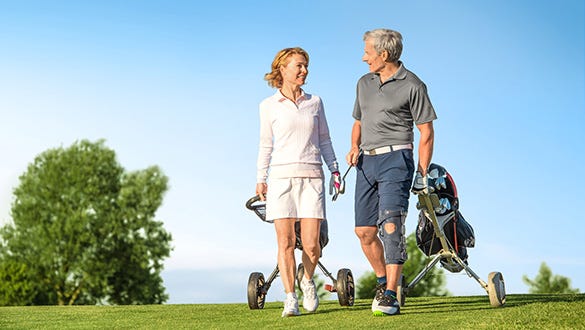- Free First Class Delivery
- Buyer Protection
- Secure Online Shopping
- Healthcare Professional? Click here
Golf


Categories
Stay healthy and relaxed with golf
Golf is certainly comparable with sports such as Nordic walking, hiking or swimming. Here you can find out how well this often sociable sport trains your body and mind.
Exercising in the fresh air, hitting the ball over the lush green grass and spending time with congenial fellow players – the life of a hobby golfer can be very good! So, it’s no wonder that golf is becoming ever more popular. The over-55 age group has not only seen the greatest growth, but it is also the largest group of players and for a good reason. A Swedish study recently came to the conclusion: Older people who regularly play golf live an average of five years longer.*
Swing for your heart and circulation
When completing a round of 18 holes, the golfer is on the move for an average of four hours and walks approx 5 miles. The whole body is used when swinging and walking and the body can use up to 1,200 calories. The comparatively low but constant level of exercise is ideal for the heart and circulation. However you will only feel the positive effects if you play regularly: It is recommended that you should work on your handicap three times a week.
Effective muscle training
Golf also helps with muscle development. Teeing off correctly uses more than a quarter of a golfer’s muscles each time. The stroke itself particularly uses the chest and shoulder muscles. These are responsible for the inwards and outwards rotation of the movement during the golf swing. The back muscles also have to work hard, while the trunk and leg muscles ensure a stable stance.
Golf relaxes
Playing golf is not only good for your physical health, but it also has a positive effect on your nervous system. The quiet of the golf course and exercising in the fresh air helps you to relieve everyday stress. The social aspect also plays a part: Spending time with like-minded people after the round is a wonderful way of relaxing. But that’s not all: Experts say that the green sport even improves stress tolerance, as every stroke requires calmness and balance.
Good for the coordination
Golf improves concentration, the sense of balance and hand-eye coordination. This is vital when you need to hit the ball in the right place at the right moment. Sports scientists at the University of Regensburg, Germany, even think that the game of golf, with its specific requirements for hand-eye coordination, can help to restore lost capabilities in those who have suffered a stroke. Another positive and important effect, particularly for older golf players, is the prevention of falls. Through constantly having to find their balance in various swing positions, golfers have a better sense of balance.
Don’t give golfer’s elbow a chance!
Golf is suitable for everyone, both young and old and for those who particularly want to get their cardiovascular system, muscles and coordination skills going and reduce stress. But golf is also a one-sided sport - at least in terms of its directional movement.
However, many golf devotees suffer from back and joint complaints, particularly if their swing technique isn’t perfect or if they train/play too intensively. One typical disorder is the so-called golfer’s elbow (epicondylitis). This condition involves inflammation of the tendon insertion that connects the muscles to the elbow bone.
The good news is that epicondylitis is particularly responsive to treatment. Altering the sequence of movements during sport and wearing an elbow orthosis for a short period of time is usually sufficient. This relieves the strained extensor and flexor muscles of the hand. These days orthosis is so small and light that they are not conspicuous under clothing. Another vulnerable area for golfers is the back. Again, changing the movement routine, allowing sufficient regeneration phases and performing additional abdominal and back muscle training is usually sufficient to take the strain off the spine.
Special back supports can additionally help to stabilise the back and reduce tension. Lumbar supports, such as Lumbamed plus E+motion, Lumbamed basic or Lumbamed plus from medi can prevent the development of lordosis by pushing the pelvis forward and thus straightening the spine.










